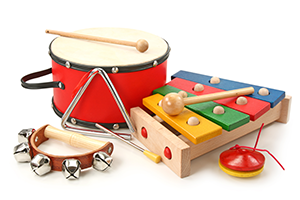Prep. Lesson 12. Louder and softer sounds II
Prior learning: Louder & softer sounds
Duration: 30 minutes
Materials: Tuned and un-tuned percussion
Keywords: Beat, singing, chanting, partners, rhymes, circle games
Difficulty: ![]()
 Melodic development
Melodic development
![]() Students put their voices in the 'elevator'.
Students put their voices in the 'elevator'.
- The class is seated. Explain that students will put their voices in an elevator, making the sound higher or lower.
- Lead the class in singing 'ooh' or 'ahh'.
- As you do so, raise your arms up and down according to the pitch.
- Students must follow your actions as they copy your voice moving up and down.
- This exercise is helpful in the exploration of pitch in this year level.
 Melodic development II
Melodic development II
![]() Students identify and practise dynamics by singing a well-known song softly and then loudly.
Students identify and practise dynamics by singing a well-known song softly and then loudly.
- Sing Rain, Rain once to the class whilst keeping the beat.
- Explain to students that the sound of rain can be loud or soft.
- Ask students whether they would like to pretend to be soft rain or loud rain.
- For soft rain, sing the song softly and instruct the class to sing quietly.
- For loud rain, sing the song with more volume and instruct the class to sing along in a louder voice.
- Ask the class whether they preferred the rain to be soft or loud.
- Ask the class if they can tell the difference between loud and soft singing.
 Rhythmic development
Rhythmic development
![]() Students identify and practise dynamics by softly and loudly reciting an imaginative rhyme.
Students identify and practise dynamics by softly and loudly reciting an imaginative rhyme.
- Recite the rhyme Engine, Engine to the class and instruct students to copy you on the next rendition. Demonstrate the rhyme, speaking in a measured cadence.
- When the class is secure in reciting the rhyme, ask students to form a line (similar to that for Big Black Train) with each student pacing their arm on the next student's shoulder.
- The first student is the driver, who you ask to make a train sound to begin the journey.
- When the 'train' moves off, ask students to recite the rhyme loudly.
- When students come to a halt, they repeat the train, but this time, they recite the rhyme softly.
 Activities
Activities
![]() Students identify and practise dynamics by singing softly and loudly and listening.
Students identify and practise dynamics by singing softly and loudly and listening.
Loud or soft singing?
- Begin by singing "Hot Cross Buns" in a gentle, calm tone. Once you've finished, ask whether you were singing loudly or softly. This encourages students to listen and analyse the volume of the music actively.
- Next, instruct the class to join you in singing the song softly'
- As they sing, observe their participation and offer guidance as needed.
- Now, inform the class that you'll sing "Hot Cross Buns" loudly. Encourage them to listen carefully, and then have them join in, matching your increased volume. This exercise helps students explore the concept of dynamics in music.
- To further reinforce their understanding, invite individual children to sing "Hot Cross Buns" in both soft and loud volumes. This strengthens their comprehension of the concept and provides an opportunity to build their confidence and self-expression skills.
- This reflection will reinforce their understanding of the differences between soft and loud sounds while fostering critical thinking and communication skills.
Loud or soft instruments
- Place a glockenspiel and a triangle (or similar classroom instruments) on a table where all students can clearly see them. This setup will facilitate their understanding of how striking force affects the volume of sound an instrument produces.
- Invite a student volunteer to come forward and demonstrate how to strike the glockenspiel firmly to produce a loud sound. After the student follows your example, allow the sound to resonate and ask the class if the sound is loud or soft. This interaction encourages active listening and engagement with the concept of sound volume.
- Next, ask another student volunteer to strike the glockenspiel gently to create a soft sound. Again, pose the question to the class, asking if the sound was loud or soft. This exercise will help students understand the distinction between loud and soft sounds.
- Tell the class that you will make a sound using the triangle. Strike it softly and ask the class to identify if the sound is loud or soft. This activity will illustrate that the concept of volume applies to various instruments.
- This lesson will help students grasp the relationship between playing technique and sound dynamics, laying the foundation for more advanced musical understanding.
The Lion and the Mouse
- Introduce the children to the lion and mouse puppets (or soft toys). Explain to them that the lion only wakes up when it hears loud music, while the mouse wakes up to soft music. This imaginative setup will help students grasp the concepts of loud and soft sounds more effectively.
- Select a familiar classroom song, such as "Starlight," and sing it quietly. As you do so, have the mouse puppet "wake up" and then fall back asleep. Encourage the class to join in, singing softly to the mouse. This activity will help students understand the impact of soft sounds on the mouse character.
- Next, sing the same song loudly, making sure the class observes the difference in volume. Invite the class to repeat the song with you, singing loudly to the lion puppet. As they sing, have the lion "wake up" in response to the louder volume. This will demonstrate the effect of loud sounds on the lion character.
- Finally, engage the class in discussing the two singing experiences. Ask them if the singing was the same or different in each instance, and encourage them to explain their observations.
 Listening
Listening
![]() Students listen to sounds from the audio player to discover whether they are loud or soft.
Students listen to sounds from the audio player to discover whether they are loud or soft.
 Visual learning
Visual learning
![]() Students use their imagination to identify whether the objects would make a loud or a soft sound.
Students use their imagination to identify whether the objects would make a loud or a soft sound.




 Video
Video
![]() Students watch and listen as Zak and Zoe identify loud and soft sounds.
Students watch and listen as Zak and Zoe identify loud and soft sounds.
 Farewell
Farewell
![]() Reinforces students' pitch ability through listening, imitation, and repetition. 'Good morning' or 'Bee, Bee, Bumblebee' are examples.
Reinforces students' pitch ability through listening, imitation, and repetition. 'Good morning' or 'Bee, Bee, Bumblebee' are examples.
Suggested lessons
Prep. Lesson 13. Longer and shorter sounds
 Students learn that sounds can be longer or shorter. AC9AMUD0
Students learn that sounds can be longer or shorter. AC9AMUD0
Prep. Lesson 14. Faster and slower sounds
 Students learn that sounds can be faster or slower. AC9AMUD01
Students learn that sounds can be faster or slower. AC9AMUD01
Prep. Lesson 15. Same and different
 Students learn that sounds can be the same or different. AC9AMUD01
Students learn that sounds can be the same or different. AC9AMUD01
